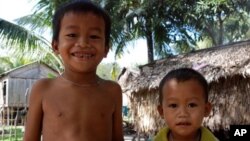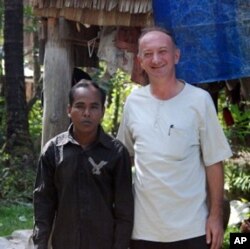More than 20 languages are spoken in Cambodia, but most are minority languages and face extinction in the coming decades.
Jean-Michel Filippi is in a race. As the foremost scholar of S'aoch, the language of one of Cambodia's minority tribes, he has only a few years to record the language before it may be lost forever. To date he has recorded 4,000 words in S'aoch. His next step is to write a grammar book on the language.
Filippi says just 10 people are fluent in S'aoch and none uses the language in their daily life. That makes S'aoch the most endangered language in Cambodia. In a decade it will likely be extinct.
For him, recording the language is one way to preserve a cultural view of the world.
"Culturally speaking a language is a unique vision of the world," Filippi said. "You can take two languages which may appear to be - if not similar then very close to each other, like French for instance and English - in fact the vision of the world which implies in French language and English language are totally, totally different. If a language disappears, a whole vision of the world disappears as well at the same time."
Cambodia's dominant language is Khmer but small ethnic groups have other languages.
The United Nations' cultural agency UNESCO warns that 19 Cambodian languages are at risk of extinction. It is not a rare problem: half of the world's 6,700 languages will likely die out by the end of the century. Most are spoken by small ethnic communities in developing nations or by groups such as Native American tribes in North America.
Blaise Kilian is UNESCO's joint program coordinator in Phnom Penh. He says there are many reasons languages die.
"When you have only a very few people speaking a language of course it is in danger of being extinct," Kilian said. "But besides this you have the environment. You have the way people, themselves, and especially the new generation, react to the changing environment. How much they are interested themselves in preserving and transmitting their own languages. So I would say it is a number of internal and external factors which play an important role besides the number of speakers."
Filippi says the S'aoch people have rejected their own language because they are extremely poor. They have decided their best bet is to adopt the Khmer language.
"In the case of the S'aoch they apparently want to get rid of their language and their cultural institution because it is linked to their poverty, to I would say their economic situation, which compared to the Khmers is a very poor one, and so on and so on," Filippi said.
The imminent extinction of S'aoch raises the question of what can be done about Cambodia's other endangered languages. With S'aoch, the only option is to write down and record as much as possible while the speakers are alive.
The situation is less dire for some languages spoken in other parts of the country. In the northeastern provinces of Ratanakkiri, Mondolkiri and Stung Treng a number of organizations are involved with youth and adult education for minority people.
One of those is Care International, which for seven years has worked with the Ministry of Education on a program teaching schoolchildren in two languages.
Care's education adviser, Ron Watt, says almost 2,000 primary school children in the three provinces last year received instruction both in their ethnic community's language and in Khmer. The program is now in 25 schools.
"Bilingual education is really spreading - people are very enthusiastic about it," Watt said.
Watt says that before the program started, the government and aid organizations had misconceptions about education for minority people. One of those misconceptions was that minority groups did not want to send their children to school.
"What we have found that that is just not the case at all - that the moment you start providing relevant education that kids can access and that kids can learn, parents are more than enthusiastic to send their kids, and kids are enthusiastic to go," Watt said.
The positive response from minority communities toward language learning programs highlights something Jean-Michel Filippi insists is essential to keeping languages alive.
"If a community wants its language to be saved and is strong enough to express the will to have its language saved, it may very well work. But you will never save a language if the community doesn't want to," Filippi said.
Cambodia's poverty does not augur well for the language survival chances of its minority peoples, many of whom are struggling to keep hold of their community land.
Language and development experts say that unless Cambodia's economic situation improves, it seems likely that it will lose far more than the S'aoch language by the end of this century.










